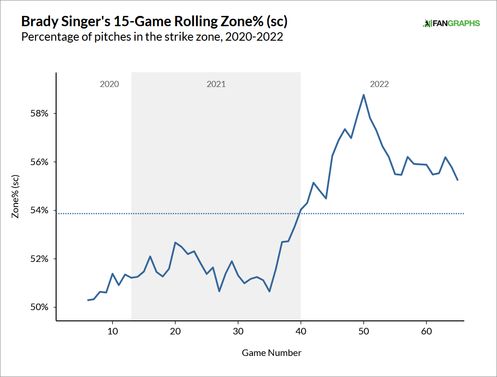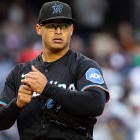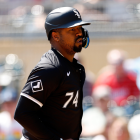
Only one week remains in the 2022 MLB regular season. Several postseason spots remain up for grabs, though five of the six division titles have already been clinched. Only the NL East remains undecided, and the wild-card races have yet to be finalized as well. A dozen teams will play in October this year.
With that in mind, our bi-weekly regular season series breaking down various trends across the league wraps up Wednesday with a look at one slugger's brutal slump, a young player figuring things out, and a pitcher breaking out. Last time we looked at Yordan Alvarez's power dip, Craig Kimbrel's adjustment, and the A's very bad offense.
Olson's September slump
When we last checked in on Braves first baseman Matt Olson in July, he was on pace for a 60-double season, something that is even more rare than 60-homer seasons. Olson has since fallen off that pace (he's now on pace for 45 doubles), which was to be expected because hitting 60 doubles is really hard.
What wasn't expected was Olson suddenly becoming one of the worst hitters in baseball. That's not hyperbole. Olson is 11 for 94 (.117) with 32 strikeouts in his last 27 games. He called his bats "low quality" while speaking with The Athletic this past weekend, adding he was "missing good pitches over the heart of the plate" and "then I got out of the zone a little bit." This is what that looks like:

Long one of the game's most disciplined hitters -- Olson's chase rate was on par with walk machines like Aaron Judge and Joey Gallo from 2019-21 -- Olson's swing decisions have collapsed this month. He's chasing out of the zone and missing more pitches in the zone, and when he does connect, he's hit a lot more average-sapping pop ups and grounders into the shift. There's not much bad luck involved in this slump. Olson's earned it.
"I've gone full dive into mechanics at one point this year, and sometimes you can get a little too far into it as well," Olson told the Atlanta Journal-Constitution this past weekend. "Finding the right line of knowing when to dig in and knowing when to relax and go hit is key. I think any little bit of that right now of taking a step back, going up there and playing baseball, grinding at-bats, that's where I'm at currently."
I supposed the good news is Olson has been through this before. He went 18 for 110 (.164) with 35 strikeouts to begin the 2020 season, and while that was a bizarre pandemic season with a short spring, Olson did pull out of that slump. He's shown the ability to adjust and escape failure. That doesn't make this any easier to sit through, but the track record says Olson can figure it out.
Tuesday night the Braves moved into a first place tie with the Mets -- they open a three-game series Friday and each have seven games remaining -- and they kept pace with New York despite Olson's slump the last few weeks. That's a testament to their depth and championship resolve. Still, to win the division and eventually repeat as World Series champs, the Braves need Olson to be a middle-of-the-lineup force. The slump is a month old. Olson has to correct his mechanical and swing decision issues now.
Cruz cutting down on chases
In terms of natural gifts and physicality, few players in the game can match Pirates shortstop Oneil Cruz. The 6-foot-7 wunderkind -- at that size he's a tallstop more than a shortstop -- lights up Statcast with premium exit velocities, elite arm strength, and shockingly great foot speed. His seemingly effortless home run against Jacob deGrom earlier this month was a sight to behold:
"When you're competing against the best pitchers in the game, the fact that as a young player to be able to continue to have at-bats like that, it's extremely important," Pirates manager Derek Shelton told the Pittsburgh Tribune-Review after the game.
The tools are there to be a superstar and, over the last few weeks, Cruz has begun to blossom and resemble a more refined baseball player. He struggled greatly when he was first called up in late June, but over the last month or so, he's been much better than the league average hitter. Here are the stats entering play Tuesday:
| PA | AVG/OBP/SLG | HR | K% | BB% | Swinging Strike Rate | |
|---|---|---|---|---|---|---|
First 49 games | 194 | .198/.242/.390 | 9 | 37.6 | 5.7 | 15.9 |
Last 30 games | 128 | .243/.320/.539 | 8 | 36.7 | 9.4 | 12.2 |
The strikeout rate remains way too high -- given his size and large strike zone, Cruz will likely always strike out a good deal, similar to fellow 6-foot-7er Aaron Judge -- though he's cut down on the swings and misses (the MLB average swinging strike rate is 11.2 percent), and also cut down on the swings at pitches out of the zone in general.
Here is Cruz's chase rate this season. He is much more disciplined now that he was earlier this year.

Exit velocity isn't everything but it is a valuable skill -- hitting the ball hard has always been important, it's just that we can quantify it now -- and it can only be taught so much. There's a point where a pitcher can either throw 100 mph or he can't. Similarly, there's a point where a hitter can either hit a ball 120 mph or he can't, and Cruz can (and has). His hard-hit ability is nearly unmatched.
That said, Cruz must improve his swing decisions and plate discipline to maximize that hard-hit ability, and turn it into consistent results. Step 1 is not chasing out of the zone. Swing at strikes, not balls, is Hitting 101. Over the last few weeks there are some signs Cruz is figuring that out against MLB pitching. Next will be further refining his approach and reducing whiffs. For now, Cruz is showing signs of progress with his discipline, and that's all the Pirates could ask from their 23-year-old tallstop.
Singer's second-half breakout
I'm not sure anyone truly expected the Royals to contend in 2022, but the club has already clinched its sixth consecutive losing season and worst record since losing 103 games in 2019. Kansas City's poor performance has already cost longtime baseball operations head Dayton Moore his job. More changes could be in order this offseason.
As far the long-term future goes, the Royals have had three promising developments. First and foremost, Bobby Witt Jr. looks as advertised. He's a mainstay on the infield. Second, Vinnie Pasquantino has come up and mashed. He looks every bit like a middle-of-the-order masher. And third, Brady Singer is having a breakout season, or more accurately a breakout second half.
The No. 18 pick in the 2018 draft, Singer made the Opening Day rotation in 2020 and was mostly fine from 2020-21, throwing close to 200 league-average innings. Singer opened this season in the bullpen, was sent to Triple-A in late April to get stretched back out to start, then resurfaced in mid May. On July 1, he owned a 4.33 ERA in 54 innings, so roughly in line with 2020-21.
Since then Singer has been one of the game's top starters. He's allowed no more than two earned runs in 11 of his last 15 starts and has a 2.21 ERA in 93 2/3 innings. Singer has held hitters to a .240/.303/.341 batting line, and while facing the lowly Tigers three times in those 15 starts helped, he also had dominant one-hit outings against the Yankees (in Yankee Stadium) and Dodgers.
"I think staying on the attack with runners in scoring position has helped me a lot. I think the past few years I've kind of been picking around guys, trying to get them to chase," Singer told Kansas City Star earlier this month. "Now, I'm trying to throw competitive pitches in the zone and kind of understand where the runners are, how many outs there are and stuff like that. I feel like I've done a lot better job this year than I have in the past."
Oftentimes when a pitcher has a breakout season, there's a new pitch or a change in pitch selection or something along those lines. That isn't the case with Singer. He's had a few individual starts in which he's thrown more changeups that usual, but it's not a consistent increase in changeup usage. More than anything, Singer's breakout comes down to what he said: competitive pitches in the zone.

Singer doesn't lack stuff. His sinker sits mid-to-upper-90s with run, and he's always gotten swings and misses from righties with his slider. The changeup is a work in progress, but the sinker/slider combination is the reason he was drafted in the first round. Singer's breakout is more about better execution with those pitches than developing a new pitch, or altering an existing pitch.
Development is not linear. It can take some young players a little longer to figure this game out than others, and that goes double when you throw in the weirdness of a shortened pandemic season. Singer did not have a conventional introduction to the big leagues, but it looks like he's beginning to find his way and deliver on his promise now. For a disappointing Royals team, it's one of their most promising developments of the season.




























